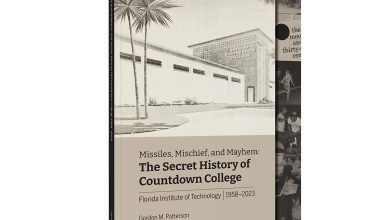Creative Writing: Not just a Carrier of Information
Interested in Creative Writing? Don’t forget to check out Florida Tech’s Creative Writing Institute this summer! The Creative Writing Institute is sponsored by the Department of Humanities and Communication, and offers participants a one-on-one chance to work with published authors.
By John Lavelle, Ph.D.
Ferdinand de Saussure made one of those “no-duh” discoveries when he noticed that language was quite arbitrary, that every language was made up of a sound or group of sounds called phonemes and ideas or idea images despite the way it might be written. A simple example of this is the word for tree. Notice I can’t even talk about the word for tree without evoking the word “tree.” I could say, however, the word for arbre or arbol in Spanish, baum in German, but I would need to invoke a word to pass on the idea of what I want to discuss. Thus the first purpose of language is not to communicate, but to be able to think or reason . This is a very important aspect of creative writing, the getting people to think in the creation of images sort of way.
For Saussure a word (a sign) is made up of the signifier—the sound of the word and the signified the idea the sound represents. For this discussion thinking of these two components as a word, the sound and the idea it represents is not quite enough. While the idea is important, especially since the more specific idea is the better idea, oak, maple, scrub apple, thorn bush, sapling, the spelling (picture) of the word on the page (since that matters in poetry) and the information it carries, what Saussure would call the signified are also important. Thus at this level, as Saussure contends, a word, that sound you hear when someone exhales breath while manipulating their vocal chords, tongue, mouth, and lips, or the sound you hear in your head when you read the word, and the idea, the picture, is a sign. It points to an idea and only an idea, not the thing itself. As with “tree” different people visualize different trees and thus the word “tree” cannot mean a specific actual tree as maple still cannot point to a specific maple.
Although Derrida would disagree, since the audio sign has not only existed long before the visual sign, and since the visual sign evokes the audio sign, one could say that writing is once removed from this idea, because we hear the word in our head once we read it, especially if it’s a foreign word (to us) that we don’t know such as albero in Italian (the signifier is detached from the signified). However, if one looks at none Western alphabetical languages, Greek included, δέντρο, or Hindi, पेड़ one could come to an opposite conclusion, although word sounds still predate written language.
What does this have to do with creative writing, you might ask? The last blog discussed words as colored pigment of a painting suspended in an oil or acrylic base brushed on to a canvass in sentences. The canvas of writing exists on three planes, that of the idea, (the picture in your head) that of the sound, and that of the word picture or what the word looks like on the page. In prose the actual appearance of the word on the page is not worried about, but in poetry it may be a deciding factor. Still in prose the word is much more than just a carrier of information, the signified, although the signified is important.
Beginning writers, many times, approach writing as a way to disseminate information, to tell a story and many times they do this almost generically using clichés and word packages, ideas to be discussed later. Telling a story is much more than disseminating information. Creative writing’s last responsibility is to disseminate information, although it always does this. It is to entertain, not necessarily in the TV or cinema way, the reader being a passive onlooker, but to transport the reader or transform the reader evoking in the reader an active participation in the creation of the text as Roland Barthes contends. Thus a reader must be delighted to read the story. It is to dance with the reader while teaching him or her new and wonderful steps.
Writers do this by using new arrangements of words that delight the reader in sound, word pictures, and images. By the way, an image here exists in the reader’s mind and is not just visual, but of all five senses. We’ve spoken about alliteration, cacophony, euphony, the different sound arrangements of words. Too many times, especially in prose, sound and rhythm are put aside when they are just as important in prose as in poetry if toned down. Specificity is also put aside or is thrown at a work like paint at a wall. Being specific in a certain way can be as clichéd as being too unspecific, if that specificity is done just like everyone else’s.
To sum up, a piece of creative writing is in its last instance, a carrier of information. Poetry is first and foremost a poem, a thing on a page of sound and pictures both in the actual words and in the images it evokes. Prose also is the thing on the page, maybe not in itself as a picture of words, but in the specific images it evokes and the sounds the sentences carry. Beginning writers usually do not want to entertain or delight the reader other than to pass on information they think is important or entertaining, such as a plot, a character(s) or some important theme. Creative writing involves much more than that.
Inspired to write something yourself? Take a look at classes at Florida Tech’s Creative Writing Institute this summer! The Creative Writing Institute is sponsored by the Department of Humanities and Communication, and offers participants a one-on-one chance to work with published authors.





